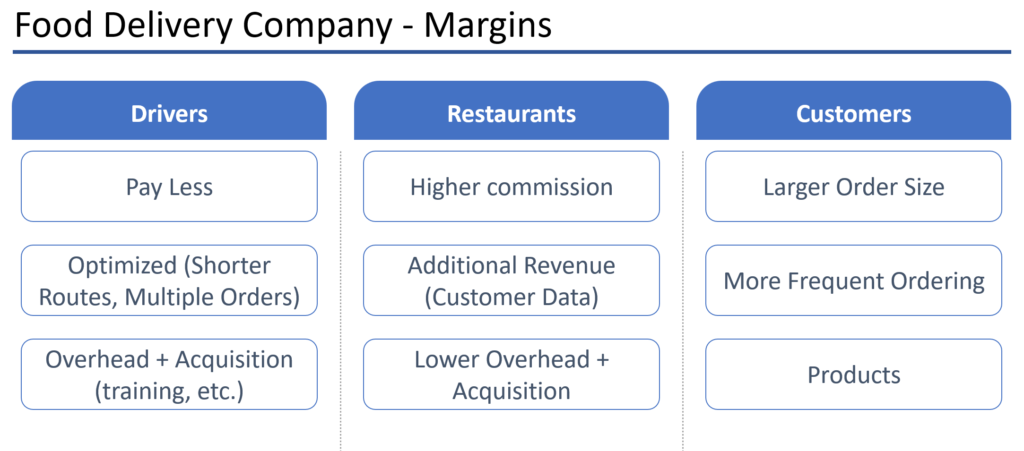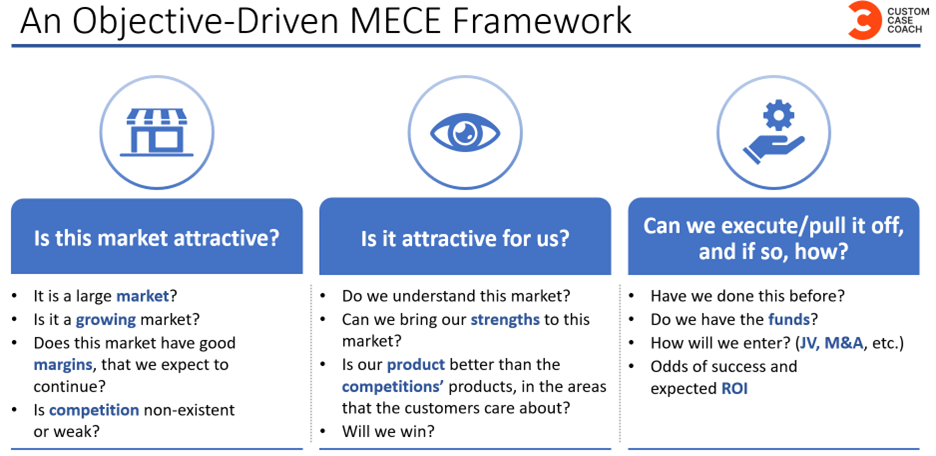Note: Don’t forget to read and work through our Masterguide to Case Frameworks if you’re still struggling with your profitability case frameworks after reading this article.
Table of Contents
Case study frameworks are crucial tools for management consultants and aspiring candidates in the consulting industry. They provide a structure to analyze and solve complex business problems, helping consultants deliver valuable insights and recommendations to their clients. In this comprehensive guide, we dive into the most essential case study frameworks, their applications, and how to effectively use them in your consulting practice.
Introduction to Case Study Frameworks
Case study frameworks are structured approaches used to analyze and solve business problems during consulting case interviews and client engagements. These frameworks help consultants break down complex problems into smaller, manageable components, allowing for a systematic and efficient approach to problem-solving.
Consultants Create Frameworks to Run Teams


Remember, frameworks are not just to be memorized. They are your tailored, objective-driven, approach to solving a problem.
Why?
Because frameworks are simply the modules that a consulting team would assign to their team members.


When creating your frameworks, think to yourself, can my buckets be assigned successfully to Team Member 1, Team Member 2, and Team Members 3 & 4?


The Importance of Case Study Frameworks
Case study frameworks are valuable for several reasons:
- They provide a structured way to approach business problems, making it easier to identify the root cause and develop actionable solutions.
- They help consultants effectively communicate their thought process, findings, and recommendations to clients and interviewers.
- They enable consultants to leverage their experience and knowledge by applying proven methodologies to new business situations.
Flexibility and Adaptability in Applying Case Frameworks
It’s essential to understand that case frameworks are not one-size-fits-all solutions. Instead, they should be viewed as flexible tools that can be adapted, combined, and customized to fit the specific problem at hand. In other words, the best case frameworks are those that can be tailored to address the unique challenges and requirements of each client and situation.
In the following sections, we will discuss some of the most commonly used case study frameworks in management consulting. We will cover their key components, when to use them, and how to apply them effectively.
Profitability Case Frameworks


The profitability framework is a fundamental case study framework that focuses on understanding the drivers of a company’s financial performance. It is most applicable in cases where the client’s primary objective is to improve financial performance, either by increasing revenue, reducing costs, or both.
If you want to read even more on profitability and how to approach it for any case type, take a look at our article here.
Do Not Regurgitate Revenue Cost
As we mentioned above, it is absolutely critical that you stay flexible and adaptable with your frameworks. This is especially true for Profitability. Gone are the days of a generic Revenue Cost framework.
Consultants do not solve real life projects with Revenue and Cost and nor should you in your cases.
Adapt and Adjust Based on the Case
The most important thing to remember about a profitability framework is that it needs to be adjusted to the case. Bucket options include (but are not limited to):
- Customer
- Competition
- Company
- Product
- Geography
- Store (breakdown)
- External/Macro
- Revenue (in context/tailored)
- Cost (in context/tailored)
- Value chain
How do you decide which buckets to use? Well, it depends on the case! For example, if the prompt tells you there are 3 products our company has and we just launched a 4th, of course you need a products bucket. If we are McDonalds (international, different models worldwide), of course you need to break it down by geography.
Listen to how I break this down to a candidate of mine here:
As an example, say we have a food delivery company that has previously focused on topline revenue growth, has negative margins, and now needs to become profitable. How would you create a framework for this? (Please don’t say revenue cost!)
Here’s one option (of multiple):


This probably looks different to what you expected. But it’s also why my candidates consistently get interviewer feedback saying their frameworking is the best they have ever seen.
Remember, every profitability case should have a slightly different set of buckets, based on the problem you are solving.
Again, for a deeper breakdown, check out our article here.


Applying the Profitability Framework
To apply the profitability framework effectively, follow these steps:
- Identify the relevant components (revenue, costs) and drivers (price, quantity, variable costs, fixed costs) that are most pertinent to the client’s problem.
- Analyze the current performance of these components and drivers, comparing them against industry benchmarks and competitors.
- Identify opportunities for improvement and develop recommendations to address these opportunities, considering both short-term and long-term implications.
When identify which areas to pursue (across profit, margin, revenu, and cost), you want to tackle any of the following:
- What’s the biggest? – This refers to the biggest piece of the revenue/expenditure pie, which has the potential to significantly impact the end result.
- What’s changing the most? – Rapid changes in a revenue/cost segment could be a significant driver and potentially fixable.
- What’s the easiest to answer or eliminate? – Opt for quick wins. These are typically yes/no types of questions that can eliminate many other factors.
- What’s the most different? – Look for differences between companies, business units, products, and geographies. Differences often equate to opportunities.
- What’s the most likely? – This is self-explanatory and refers to the most probable source of revenue/cost issues
Market Entry Case Frameworks


The market entry framework is used to evaluate the attractiveness and feasibility of entering a new market or launching a new product. It helps consultants assess the potential opportunities and risks associated with market entry and develop a comprehensive strategy for successful market penetration.
Key Components of the Market Entry Framework
Just like with profitability, you have to tailor your framework to the case prompt.
One option for a market entry framework is as follows:
- Market Analysis: Assessing the size, growth, and dynamics of the target market.
- Competitive Landscape: Evaluating the competitive forces and players in the market.
- Internal Capabilities: Analyzing the company’s strengths, weaknesses, and resources to enter the market.
- Entry Strategy: Determining the best approach to enter the market, such as organic growth, joint ventures, or acquisitions.
But, the above is just one option. We could also have a Market, Company/Competition, and Financials framework. However, ideally we would articulate it as follows:




Now, remember that all of the above is just for the question Should We Enter This Market?
A different market entry question might be “Our Client has determined that x market is attractive and wants to enter. They have brought us to figure out if we should”. This needs a different framework.
Or, the question might be “Our client has decided to enter x market. How should we enter?” The above frameworks don’t work here!
As a final example, perhaps the case tells us “We are evaluating between 3 markets to enter. Which one should we enter?” Again, new framework needed.
To understand how to tackle these more unconventional market entry cases, please take a look at our 360 degree course.
The Porter's Five Forces Case Framework
Porter’s Five Forces is a widely recognized case study framework developed by Harvard Business School professor Michael E. Porter. It helps consultants analyze the competitive forces shaping an industry and understand the attractiveness and profitability of a market.
Key Components of Porter’s Five Forces Framework
The Porter’s Five Forces framework consists of five main components:
- Threat of New Entrants: The ease with which new competitors can enter the market and challenge established players.
- Bargaining Power of Suppliers: The ability of suppliers to influence the terms and conditions of their business relationships with companies in the industry.
- Bargaining Power of Buyers: The ability of customers to influence the terms and conditions of their business relationships with companies in the industry.
- Threat of Substitute Products or Services: The likelihood that customers will switch to alternative products or services that fulfill the same need.
- Rivalry Among Existing Competitors: The intensity of competition among companies within the industry.
When to Use Porter’s Five Forces Framework
The Porter’s Five Forces framework is most applicable in cases where the client is considering entering a new market, launching a new product, or assessing the competitive landscape of an industry.
Applying Porter’s Five Forces Framework
To apply the Porter’s Five Forces framework effectively, follow these steps:
- Analyze each of the five forces, considering their impact on the industry’s attractiveness and profitability.
- Identify the key drivers and trends influencing each force and assess their potential implications for the client.
- Develop recommendations to address the opportunities and challenges posed by the competitive forces, considering both short-term and long-term strategies.
The SWOT Analysis Framework


The SWOT analysis is a widely recognized case study framework that helps consultants evaluate a company’s internal strengths and weaknesses as well as external opportunities and threats. This framework enables consultants to identify key strategic issues and develop recommendations to address them.
Key Components of the SWOT Analysis Framework
The SWOT analysis framework consists of four main components:
- Strengths: The internal capabilities and resources that give the company a competitive advantage.
- Weaknesses: The internal limitations and vulnerabilities that hinder the company’s performance.
- Opportunities: The external factors that the company can capitalize on to improve its performance.
- Threats: The external factors that pose risks to the company’s performance and success.
When to Use the SWOT Analysis Framework
The SWOT analysis framework is most applicable in cases where the client is seeking to improve its overall performance or address specific strategic issues.
Applying the SWOT Analysis Framework
To apply the SWOT analysis framework effectively, follow these steps:
- Identify the company’s key strengths and weaknesses, considering factors such as resources, capabilities, and market position.
- Analyze the external environment, identifying opportunities and threats that may impact the company’s performance.
- Develop recommendations to leverage the company’s strengths, address weaknesses, capitalize on opportunities, and mitigate threats.
Growth Case Frameworks


The growth strategy framework focuses on identifying and evaluating potential avenues for a company to achieve revenue and market share growth. This framework helps consultants develop a strategic roadmap for the client’s expansion and growth.
Key Components of the Growth Strategy Case Framework
One growth strategy case framework can be broken down into four main components:
- Market Penetration: Increasing sales of existing products or services in current markets.
- Market Development: Entering new markets with existing products or services.
- Product Development: Introducing new products or services in existing markets.
- Diversification: Expanding into new markets with new products or services.
Remember, however, just like with profitability and market entry cases, you need to listen to the prompt and adjust this framework accordingly to the prompt and company context. Different growth prompts will have different case frameworks.
When to Use the Growth Strategy Case Framework
The growth strategy framework is most applicable in cases where the client is seeking to expand its business, increase market share, or explore new growth opportunities.
Applying the Growth Strategy Framework
To apply the growth strategy framework effectively, follow these steps:
- Assess the company’s current performance, market position, and growth potential.
- Identify potential growth opportunities across the four growth strategy components, considering factors such as market attractiveness, competitive landscape, and internal capabilities.
- Evaluate the feasibility and risks associated with each growth opportunity, taking into account factors such as market entry barriers, resource requirements, and potential synergies.
- Develop a strategic roadmap for the client’s growth, prioritizing the most attractive and feasible growth opportunities.
Tips for Successfully Applying Case Study Frameworks
To effectively apply case study frameworks in your consulting practice, consider the following tips:
- Don’t rely solely on case frameworks: Remember that frameworks are just one tool in your problem-solving toolkit. Use them as a starting point, but be prepared to adapt and customize them to fit the specific problem at hand.
- Listen carefully to the client’s needs: Understand the client’s objectives, priorities, and constraints before selecting and applying a framework. Tailor your approach to address the client’s unique needs and circumstances.
- Stay flexible and adaptable: Be prepared to adjust your approach as new information emerges or as the client’s needs evolve. Be open to combining and customizing frameworks to develop a tailored solution.
- Communicate your thought process clearly: Clearly explain the rationale behind your chosen framework, the steps you took to apply it, and the insights and recommendations that emerged from your analysis. This will help ensure that your client and interviewers understand and appreciate your approach.
Enroll in our 360 course. This comprehensive course focuses heavily on building up your frameworking optimally. To get a better understanding of how to create killer case frameworks, start with our master article on case frameworks.
Conclusion
Mastering case study frameworks is crucial for success in the consulting industry. By understanding the key components, applications, and best practices for applying these frameworks, you can develop a strong foundation for effective problem-solving and strategic thinking.
Remember to stay flexible, adaptable, and customer-centric in your approach, and always be prepared to learn and grow as you refine your skills in applying case study frameworks. By doing so, you can unlock unparalleled insights and deliver exceptional value to your clients and interviewers alike.
Recommended For You
Want to learn how to become a master in frameworking? Found this article useful? We recommend the following to help you level up and get that offer:










